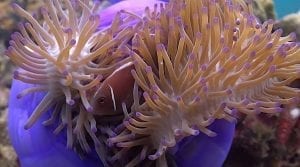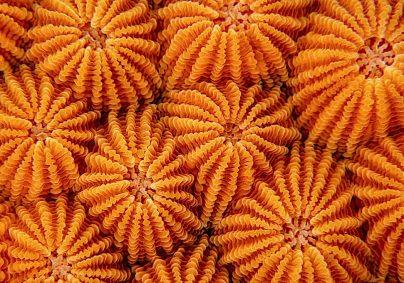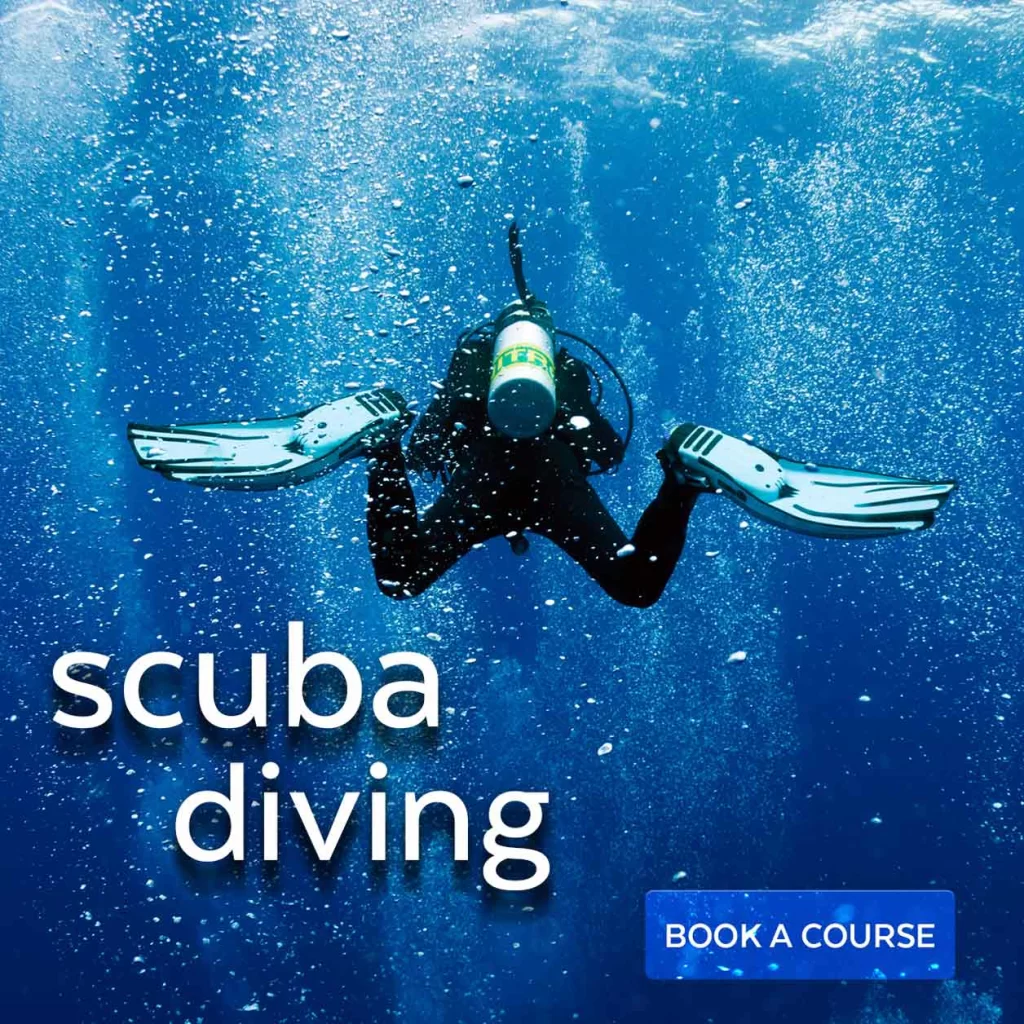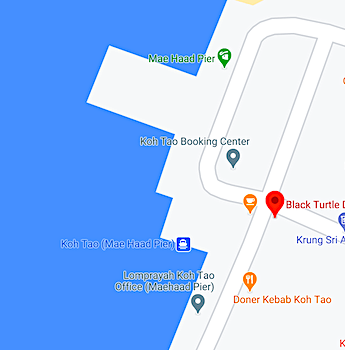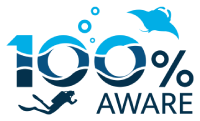Importance of Sea Turtles to Marine Ecosystems
Sea Turtles are critical to the biodiversity of the Ocean and are major contributors to healthy ecosystems.
Among their many benefactions, Sea Turtles help the Coral Reef ecosystem remain productive and healthy and they also play an important role in maintaining the food web balance.
We are now witnessing significant change in our Oceans due to a large and continuing reduction in the numbers of Sea Turtles worldwide.
Sea Turtle Population Decline
Unfortunately, as Sea Turtle numbers decline, so does the important effect they have on our Ocean ecosystems.
As responsible Marine Protectors and Ocean Ambassadors, it is important to understand the role Sea Turtles have in maintaining healthy marine and terrestrial ecosystems.
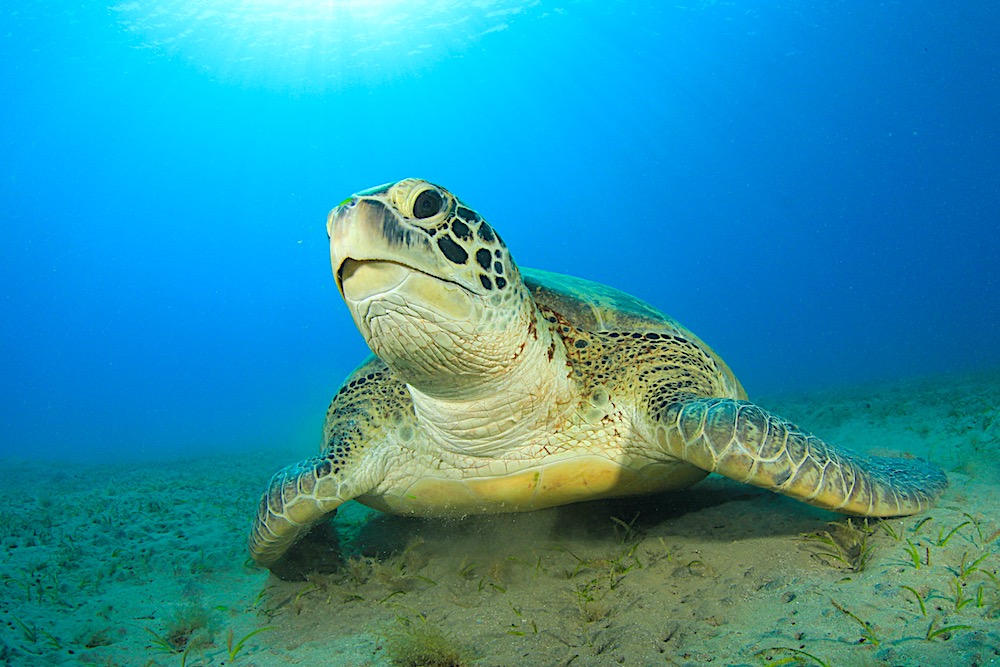
Green Sea Turtles – Keeping Seagrass Beds Healthy
A Green Sea Turtle is one of a small number of large herbivores that eat seagrass and consistent grazing increases the nutrient content and productivity of seagrass blades helping to maintain healthy seagrass beds.
A reduction in the Green Sea Turtle population leads to the seagrass becoming overgrown, interfering with Ocean currents and obstructing light reaching the seabed.
This causes an increase in decomposition that leads to the growth of slime mold and the seabed becomes overpopulated with algae, fungi, microorganisms and invertebrates.
Green Sea Turtle Identification & Behaviour
Green Sea Turtles like eating fresher seagrass, a few centimeters from the bottom of the blade. This keeps the seabed well-groomed with older upper parts of the seagrass blade floating away rather than accumulating at the bottom.
Scientists have found this decreases the supply of nitrogen to seagrass roots that has a positive impact on the nutrient cycle, plant species, density of marine life and predation that maintains a healthy ecosystem.
A decrease in the population of Green Sea Turtles reduces the productivity of the food web and by default the amount of food available for people.
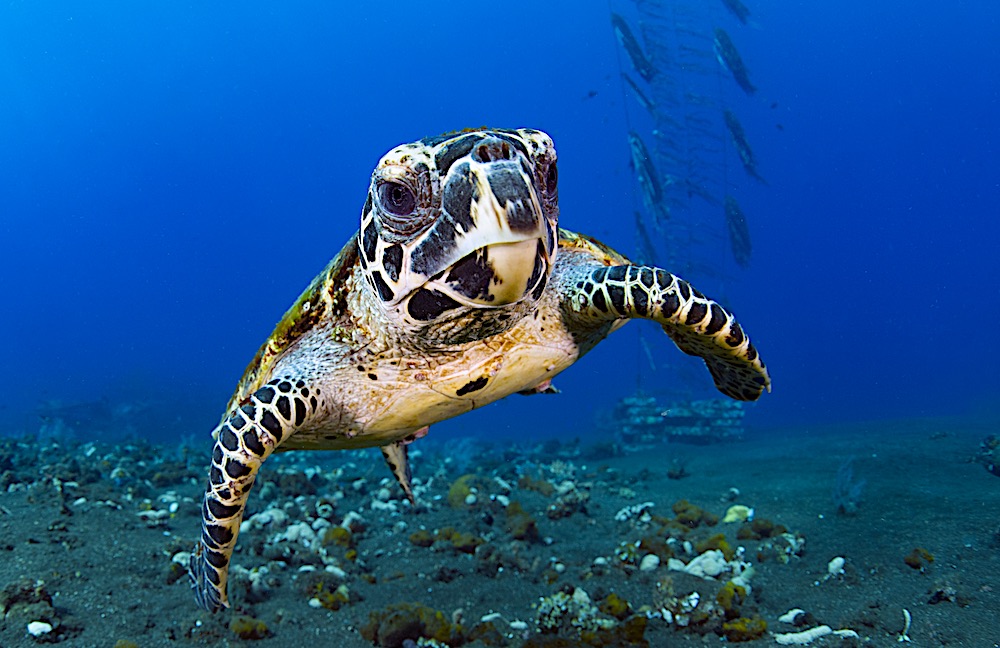
Hawksbill Sea Turtle – maintaining the Foundation of Coral Reefs
Hawksbill Sea Turtles are omnivorous, which means they eat plants and other animals, however, their favourite food are sea sponges.
Sea sponges compete aggressively with reef building corals for space on the reef and a healthy population of Hawksbill Sea Turtles ensure the population of sea sponges remains under control.
However, if the population of Hawksbill Sea Turtles decreases, sea sponges can quickly spiral out of control and cause fundamental damage to the Coral Reef.
Hawksbill Sea Turtle Identification & Behaviour
Sea sponges have chemical defences and can also change their physical properties, which deters fish and other marine animals from eating them.
However, when a Hawksbill Sea Turtle eats a marine sponge, other species will eat parts of the sponge they usually cannot get too.
If the Hawksbill Sea Turtle population declines, sea sponges begin to dominate the reef, which changes the very foundation of the Coral Reef and marine ecosystem as we know it.
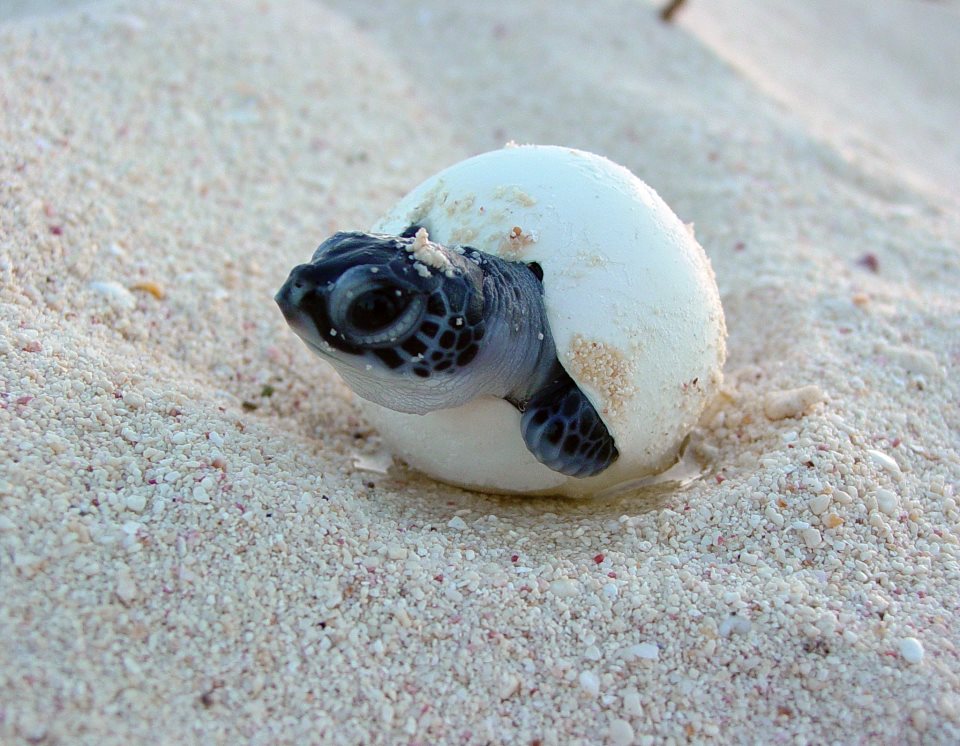
Nesting Sea Turtles – Sand Dune Ecosystems
Nesting Sea Turtles provide a concentrated and much needed source of high-quality nutrients to sand dune ecosystems.
Sea Turtle eggs provide vital nutrients such as nitrogen, phosphorus and potassium that soak into the beach dune ecosystems.
If the eggs hatch, nutrients are left behind in the eggshell and embryonic fluid.
Nesting Sea Turtles Species Distribution
If the eggs do not hatch, even more nutrients will enter the food chain with plants absorbing some nutrients and others dispersed to small organisms that live in the sand.
This helps sustain the growth of various plants and vegetation, stabilizes the shoreline, including their nesting habitats and provides food for a variety of herbivores.
This also leads to nesting Sea Turtles influencing species distribution. Sea Turtles play an important part in maintaining the food web balance.
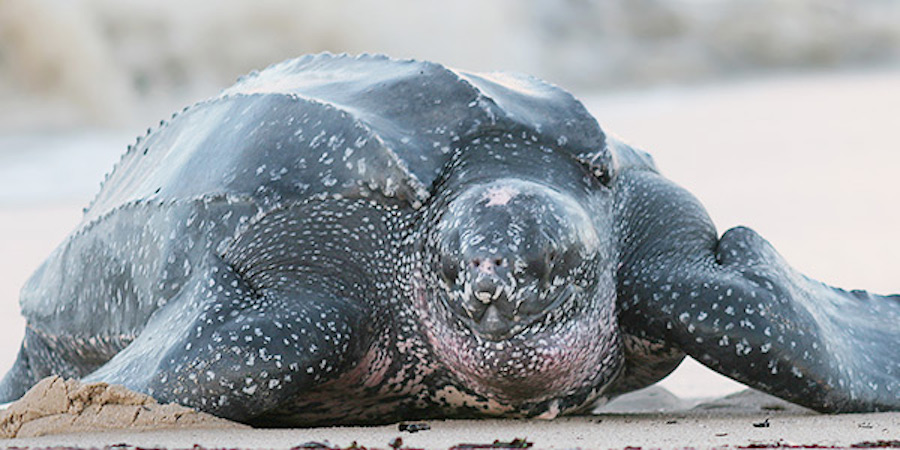
Leatherback Sea Turtle – Jellyfish Predator
The largest Sea Turtle is the Leatherback and they travel further than any of the other species of Sea Turtles, grow over 2 meters in length and can weigh up to 700kg.
Leatherback Sea Turtles, somewhat surprisingly eat Jellyfish and they consume large amounts daily to maintain a healthy diet.
A Leatherback Sea Turtle has been known to consume 200kg of Jellyfish a day and this huge appetite also plays an important role in balancing the ecosystem.
Leatherback Sea Turtles migrate across entire Oceans and as they consume significant amounts of Jellyfish, they play an important role as one of the top jellyfish predators.
Leatherback Sea Turtle Identification & Behaviour
A declining Leatherback Sea Turtle population means an increase in the jellyfish population.
This is a serious concern and when combined with declining fish stocks caused by overfishing, has seen a proliferation of Jellyfish across the world.
Less fish means less competition for food and as Jellyfish pray on fish eggs and larvae, this also impedes recovery of fish stocks.
Unfortunately, a continuing decline in the population of Leatherback Sea Turtles has seen further shifts in species dominance from fish to jellyfish.
Other species of Sea Turtle also consume Jellyfish including Loggerhead Sea Turtle and Green Sea Turtles.
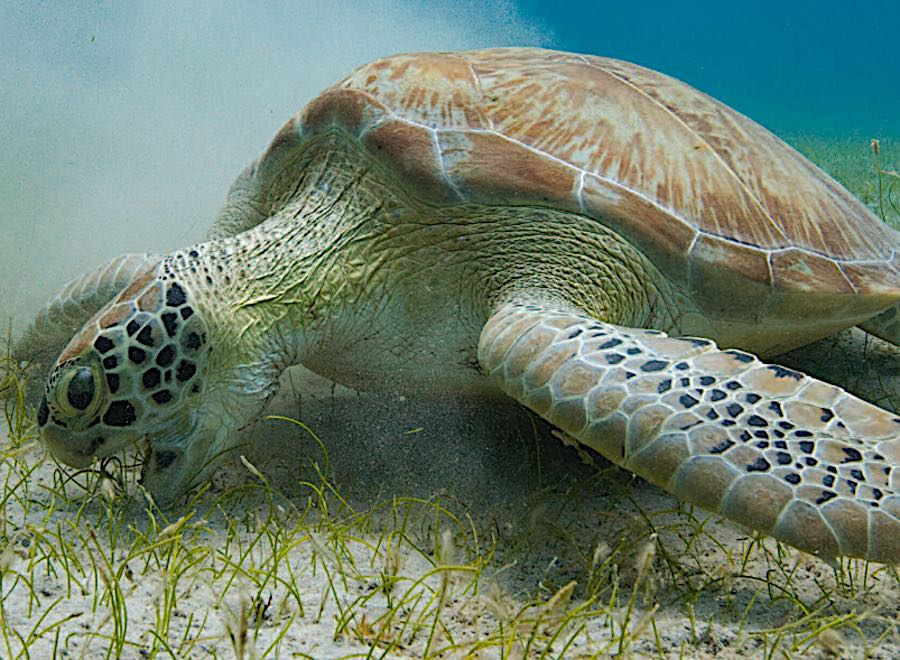
Sea Turtles provide Habitat and Food
Sea Turtles are almost an ecosystem in themselves and they provide habitat to a large and diverse range of marine animals and form symbiotic relationships with a multitude of different species.
More than 100 different species of epibionts have been identified on Loggerhead Sea Turtle shells.
The barnacles, algae and other epibionts that live on Sea Turtles then provide a food source for small fish and shrimp that live on the reef.
Sea Turtles & Epibionts
Cleaner Wrasse and shrimp establish cleaning stations that Sea Turtles visit, which benefits the cleaner fish and the Sea Turtle, who gets a skin and shell manicure that reduces drag as it swims around the Ocean.
There is even a species of Wrasse that only eat specific barnacles found on Green Sea Turtle shells.
You often see a Remora sucker fish accompanying Sea Turtles (especially larger ones) when they are swimming around.
Sea Turtles & Symbiotic Relationships
Remora fish eat parasites such as Copepods that attach themselves to the shell of Sea Turtles and eat skin that the Sea Turtle sheds, plus small scraps of food the Sea Turtle does not eat.
This relationship is mutually beneficial for the Sea Turtle and the Remora, as it uses its host for transport and protection from predators.
As the population of Sea Turtles continue to decline, certain species of fish and shrimp are being forced to develop new, less successful methods of survival.
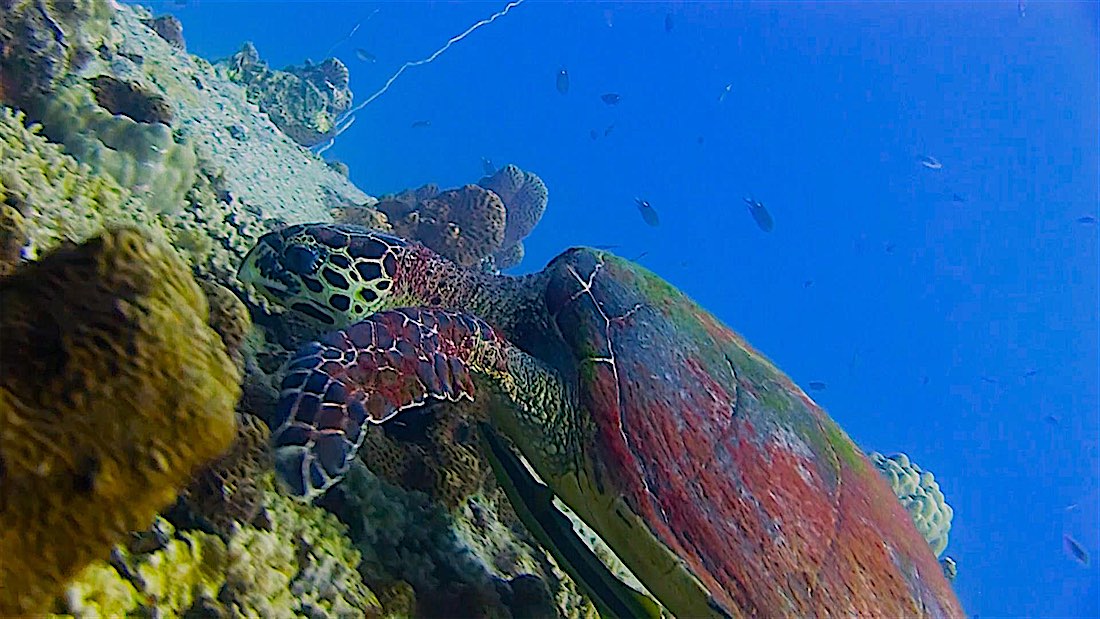
Sea Turtles distribute Marine Diversity across the Worlds Oceans
During their lifetime, Sea Turtles migrate thousands of miles across the worlds Oceans and seas.
These long migrations are thought to play an important part in increasing the range and genetic diversity of different species of barnacle.
Sea Turtle Migrations
Species of barnacle that live on a host, such as a Loggerhead Sea Turtle are thought to play an important role in sustaining the diversity of Oceans.
Continuing declines in Sea Turtle populations reduces these important impacts.
Why are Sea Turtles an Endangered Species?
Worldwide numbers of Sea Turtles have decreased dramatically over the last 200 years and this decline in species population is increasing.
Six of the seven species of Sea Turtles are classified as threatened or endangered due to human actions.
Two of those species, the Green Sea Turtle and the Hawksbill Sea Turtle live in the warm, tropical sea around Koh Tao and the Hawksbill Sea Turtle is listed as critically endangered.
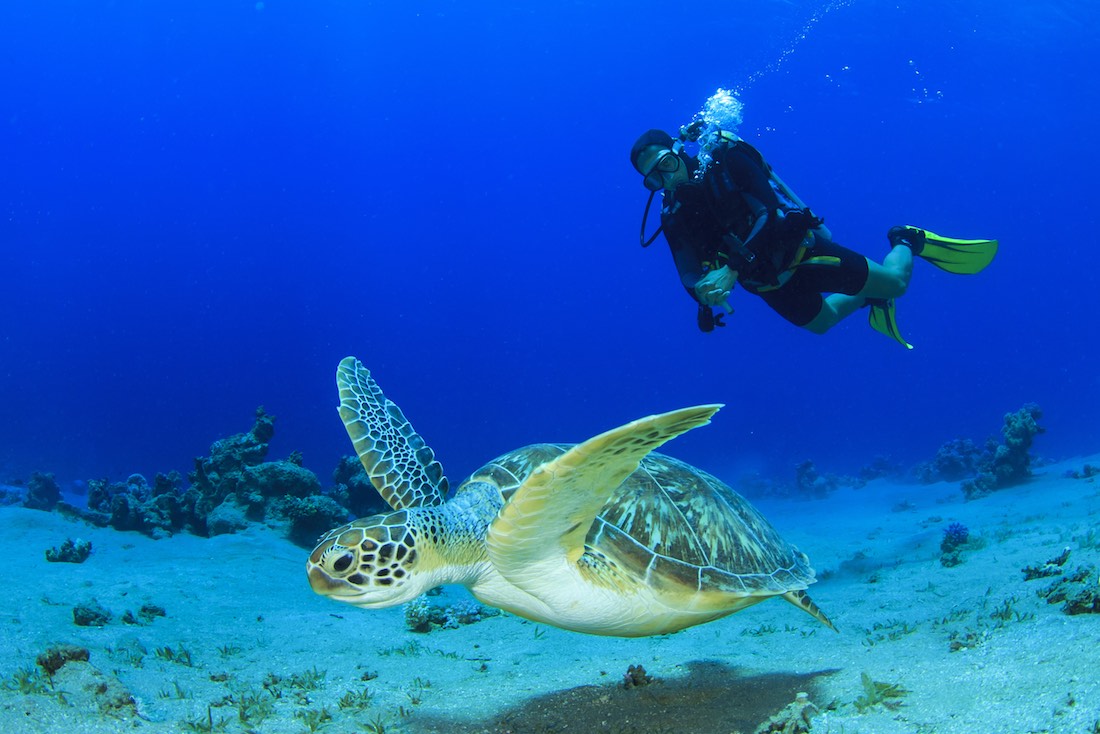
What Significant Threats are Sea Turtles facing?
The International Union for Conservation of Nature (IUCN) has identified the five most significant threats to the Sea Turtle’s existence.
1. Commercial Fishing and Bycatch
Sea Turtles are accidentally caught or entangled in commercial fishing nets, which is often fatal as Sea Turtles breathe air and need to surface at regular intervals. If they become entangled, they will often drown.
Longline fishing is prone to the incidental catching and killing of Sea Turtles.
Modern fishing practices can also damage Sea Turtle habitat and severely impact the food web.
2. Direct take or illegal Fishing
Sadly, across our planet Sea Turtles are still illegally poached.
This is despite trade of all 7 species of Sea Turtle being banned by CITES (Convention on International Trade in Endangered Species of Wild Fauna & Flora)
Sea Turtles are poached and traded for their eggs, meat, skin and their shells.
For centuries Hawksbill Sea Turtles have been hunted for their beautiful gold and brown shells, which are used to create jewellery and other luxury items and is the main reason this species is critically endangered.
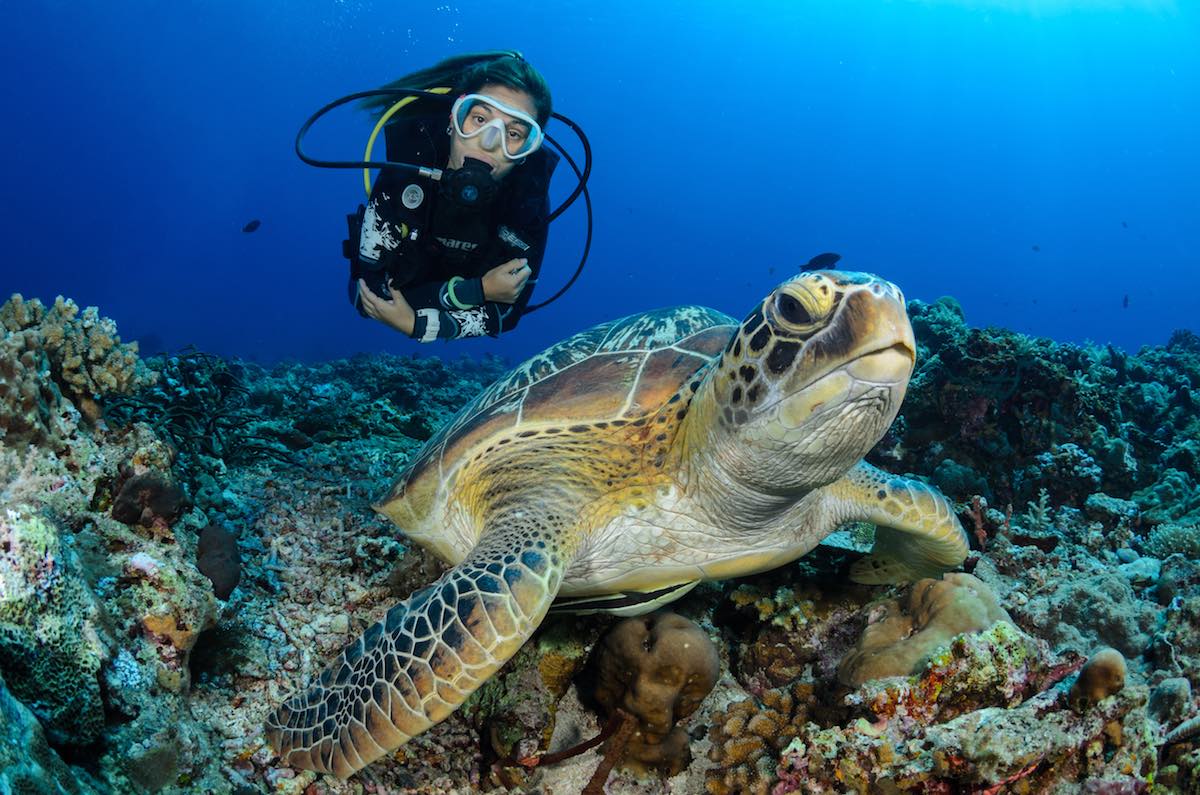
Sea Turtles are Endangered Species
Unfortunately, many parts of the world lack the law enforcement necessary to police this, or due to corruption turn a blind eye at a practice that has been common for centuries within some communities.
There are still a few countries that allow the trade of Hawksbill Sea Turtles to continue today, citing cultural practices dating back 400 years.
3. Coastal Development
The huge increase in coastal development over the last 20-30 years has had a negative impact on Sea Turtle nesting habitats.
Increases in construction, tourism, boat traffic, dredging and other environmental impacts have all had a detrimental effect on the natural habitats Sea Turtles use for nesting.
Artificial light from coastal infrastructure such as hotels pose another threat to nesting turtles.
The lights can cause disorientation with young hatchlings not finding their way to the Ocean and discourage females from nesting at all.
4. Pollution
Ocean trash is a huge problem now with the ICCUN estimating approximately 8 million tons of plastic enters our Oceans annually.
Plastics, petroleum by-products and discarded fishing equipment make up a large percentage of deadly marine debris that can hurt or kill Sea Turtles who ingest or become entangled.
Jellyfish and sea sponges form a major part of the diet of some species of Sea Turtles and sadly, Sea Turtles can mistake plastic for jellyfish and other general marine debris as a food source.
A 2015 worldwide study partly funded by CSIRO Ocean & Atmosphere, estimated 52% of Sea Turtles have ingested trash.
5. Climate Change
The temperature of a Sea Turtle egg during the incubation period can determine the sex of the Sea Turtles off-spring.
Warming air temperature means warmer water and sand temperature and this rising temperature results in fewer male hatchlings and disrupts efficient reproduction patterns.
Rising global temperatures have also seen an increase in storms that can destroy the reef that some Sea Turtles live on, or the beaches they nest at.
As the frequency of extreme weather events increase, critical Sea Turtle habitats and normal Oceanographic processes will be seriously disrupted or even destroyed.
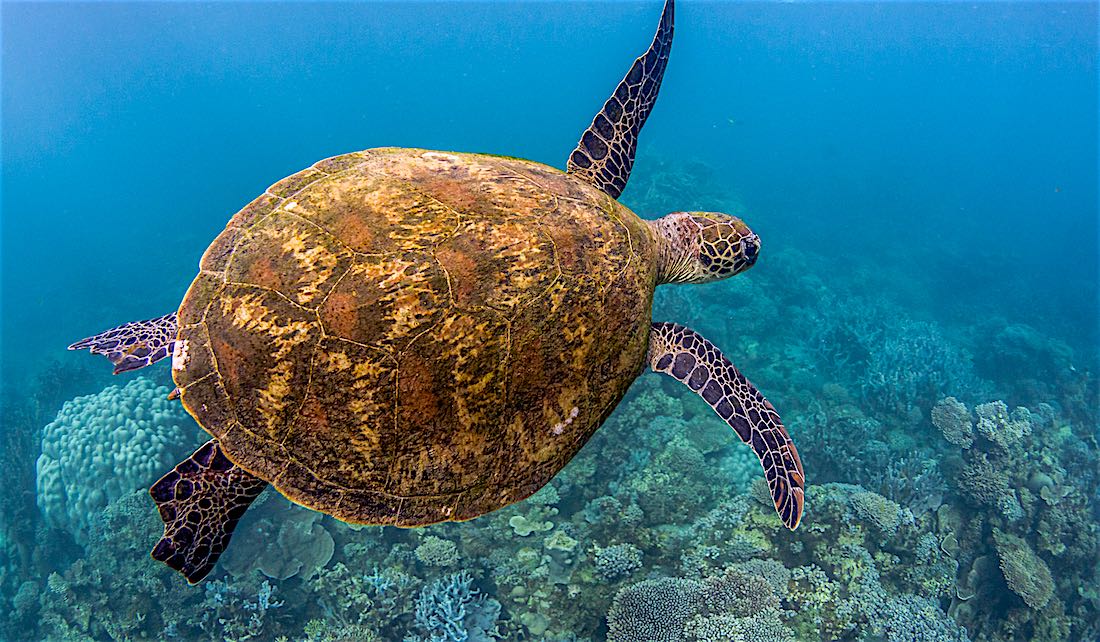
What can you do to help Sea Turtles?
There are many ways you can help the plight of Sea Turtles and we offer a few easy ways that you can start with right away.
Make smart seafood choices
- Ask where and how your seafood was caught. Only buy seafood from responsible fishing operations that use fishing techniques that do not harm or kill Sea Turtles.
Educate friends and family about sustainable fishing practices
- Share your knowledge about the plight of Sea Turtles and the devastating effects modern commercial fishing techniques have on the Ocean environment and the health of Sea Turtles.
Limit your use of plastic and try and eliminate using Single Use Plastic
- Carry reusable water bottles and switch plastic shopping bags to a reusable cloth bag.
- If you order takeaway provide the restaurant with reusable containers and support restaurants and businesses that support eliminating single use plastics in their business activities.
- Stop using single use plastics when there are reusable alternatives and replace plastic with more eco-friendly options.
Participate in Dive Against Debris dives, Beach Clean Ups and Microplastic surveys
- Get wet! Sign up for the next Dive Against Debris and help clean up some marine trash in your local area and contribute to improving the health of our Ocean ecosystems.
- Through local volunteer efforts, this great citizen science program provides valuable information about marine debris that can help inform policy change.
- Alternatively, if conducting a beach clean up, the Cleanswell App allows you to record the type of trash you find on the Ocean Conservancy global Ocean trash database.
- The data delivers a global snapshot of Ocean trash, helping researchers and policy-makers to make inform decisions and solutions.
Support Sea Turtle Conservation and Get Involved
- The oldest Sea Turtle research and conservation organization is The Sea Turtle Conservancy.
- The STC’s mission is to ensure the survival of Sea Turtles in the Caribbean, Atlantic and Pacific through research, education, training, advocacy and protection of the natural habitats that they depend upon.
- Other conservation organizations at the forefront of Sea Turtle conservation include the World Wildlife Fund and the Oceanic Society.
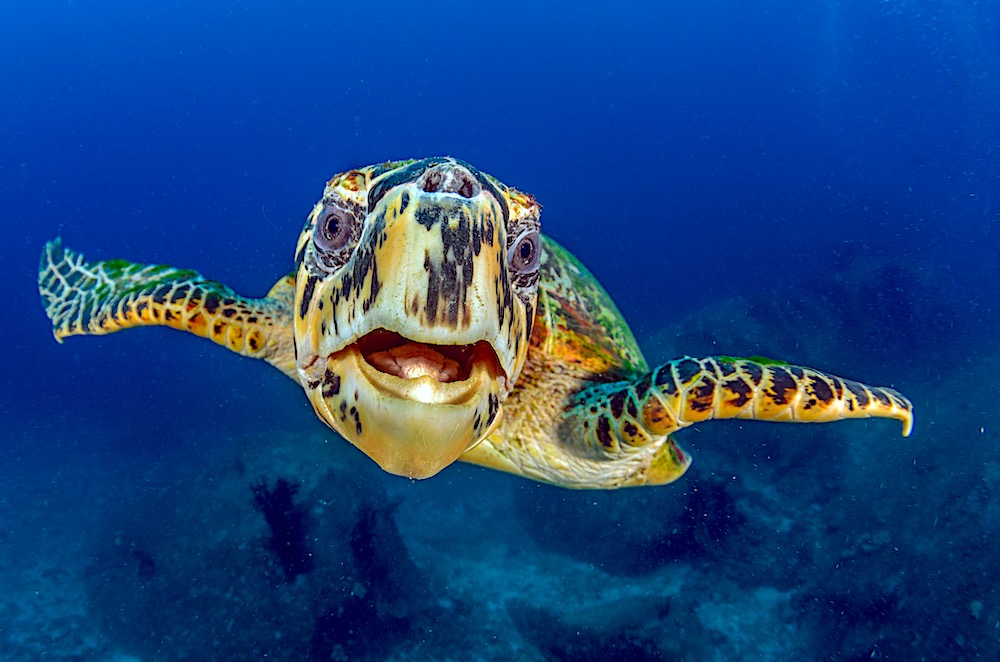
What can the world do to help Sea Turtles?
Despite decades of concern by scientists and conservationists about the plight of Sea Turtles and the threats they face, there is no international agreement that fully protects them.
Sea Turtles are highly migratory, travelling long and far across the worlds Oceans and this is at the heart of the problem.
To truly protect Sea Turtles many countries and cultures must work together and cooperate.
This must include:
Increased capacity of National governments to Act
- National governments enforcing CITES regulations and strengthening their domestic legislation to restrict trade of Sea Turtles and Sea Turtle products.
- Improvements in investigating and enforcing the law in the market place is needed.
Enhanced regional cooperation between national governments
- Strengthen coordination and collaboration and promote information sharing on the illegal international trade, such as smuggling methods and trade flows between national governments.
- Existing agreements already include joint information sharing and capacity building initiatives.
- Build on these especially in areas where the migration patterns of Sea Turtles mean they are crossing multiple borders and entering different jurisdictions.
Raise awareness about the illegal Sea Turtle shell trade
- Despite all seven species of Sea Turtles listed as endangered in appendix I of the Convention on International Trade in Endangered Species of Wild Fauna and Flora (CITES) and prohibition of international commercial trade of Sea Turtles, Sea Turtles are still illegally poached.
- According to a study commissioned by the CITES Secretariat in November 2019 illegal trade in marine Sea Turtles continues.
- Although globally outlawed in 1977 the Bekko trade (tortoiseshell) continues on the black market.
- Illegal trade flows from South East Asia to countries such as China, Japan, Taiwan, Hong Kong and where there is a high demand for Bekko products.
- Investigations have also shown these outlawed Bekko products readily available in Latin America.
- The United States is the world’s second largest market for illegal wildlife products, with returning tourists unaware they are contributing to the decline of critically endangered species, bringing these products back from abroad.
- As the country most responsible for the worldwide trade in tortoiseshell over the past two centuries, Japan warrants consideration both for its historic role in the decline of Hawksbill Sea Turtle populations worldwide and its continued legal domestic trade.
- In Japan, the country most responsible for trade in tortoiseshell, it is still legal to sell tortoiseshell products domestically.
- We must educate and raise awareness among key players such as local communities, fishermen and traders in countries of origin and the consumers in countries where there is demand.
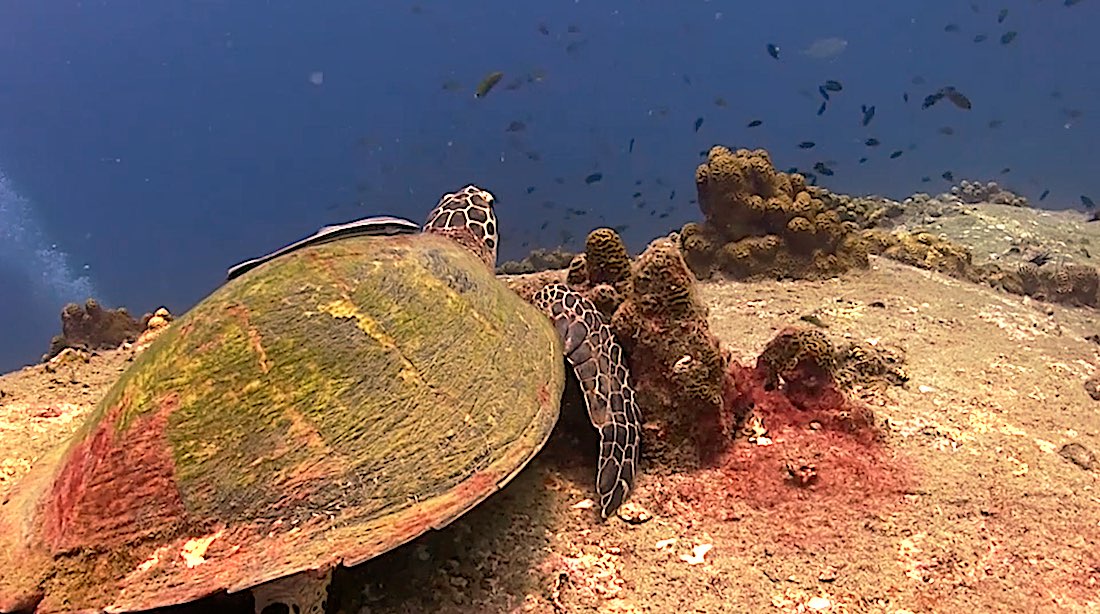
Are Sea Turtles facing Ecological Extinction?
As we have shown Sea Turtles play a very important part within Marine ecosystems.
Travelling thousands of miles across Oceans, various species of Sea Turtles help maintain healthy sea grass beds, provide important nutrients to nesting dunes and ensure our Coral Reefs remain strong and healthy.
However, with populations declining rapidly and two Sea Turtle species, Kemp Ridley and Hawksbill Sea Turtle now critically endangered, there is a real danger that Sea Turtles are heading towards ecological extinction.
This occurs when the number of Sea Turtles becomes too small to continue to contribute to its ecological role as a major contributor to the amazing diversity that our Oceans require to remain healthy.
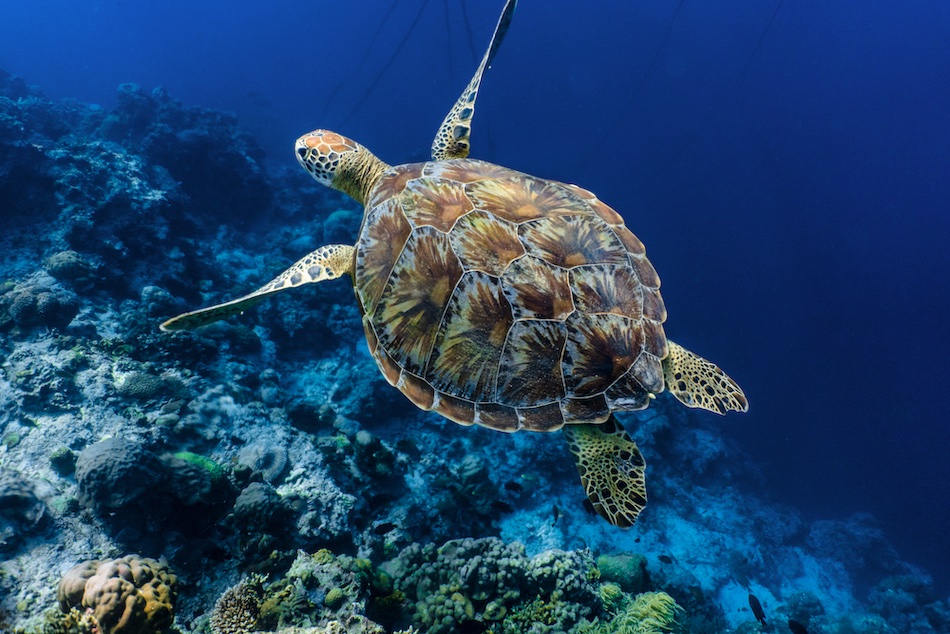
Sea Turtle Awareness Course in Thailand
Hawksbill Sea Turtles and Green Sea Turtles are regular visitors to the warm, tropical sea surrounding Koh Tao and are quite often seen when scuba diving at many of the dive sites.
Snorkel tours around the island provide visitors with another opportunity to see these magnificent marine inhabitants in their natural environment.
A local citizen science group – Koh Tao Turtles – has been monitoring the local Sea Turtle population for the last 10 years and tracks, monitors and helps to identify Sea Turtles to help conserve this iconic species.
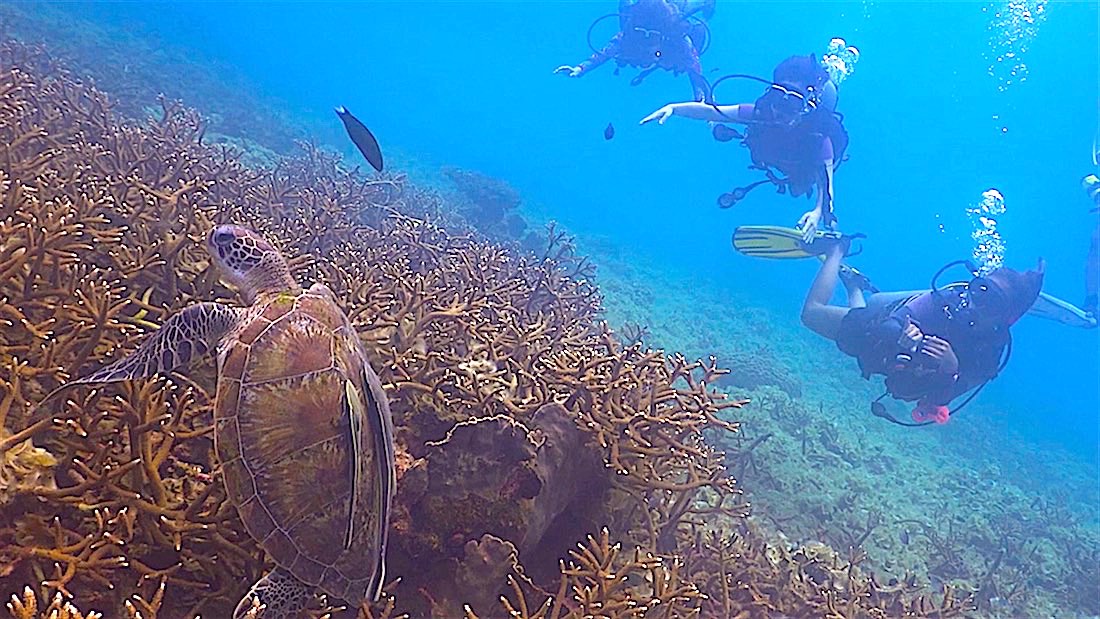
Sea Turtle Marine Conservation Course
Black Turtle Dive team have been involved with local conservation efforts for 15 years and offer many marine and land-based conservation courses to visitors who want to get involved and learn how to protect and conserve the local environment.
The Sea Turtle Awareness one day foundational course is one such course that helps increase awareness of Koh Tao Sea Turtles and is available to anyone from 10 years of age.
The course can be conducted and completed with scuba diving or snorkeling at popular bays around Koh Tao where Sea Turtles are seen daily.
Sea Turtle Awareness Koh Tao
A morning session offers an introduction to the seven main species of Sea Turtles, educational handouts including a Sea Turtle Identification key and a 2-hour interactive presentation.
Afternoon practical sessions include either 2 Open Water scuba dives or snorkeling sessions as customers get to see Sea Turtles in their natural environment.
The Sea Turtle Awareness course concludes with a debriefing and feedback session on species identification, behaviour witnessed and guidelines on what we can all do more of to protect this amazing and endangered marine species.
